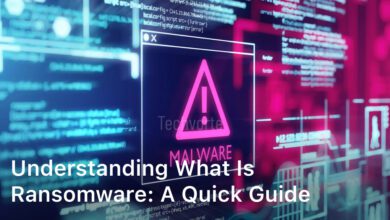Today, cybersecurity risks are growing fast. Knowing about trojan malware threats is very important to us.
Modern trojans are complex, demanding smart awareness and actions to prevent data breaches.
This introduction will help individuals and organizations strengthen their online safety.
It will equip you with key insights to protect your important data against these hidden dangers.
The Evolution of Trojan Malware Threats
Do you know, the world of cyber safety keeps changing. A key player in this change is trojan malware.
It started simple but now is a complex weapon for cybercriminals.
Origins of Trojan Malware and Its Development
The name “trojan malware” comes from the ancient Greek story about a sneaky wooden horse that caused Troy’s defeat.
At first, trojan malware was basic but good at tricking people to get into their computers.
As technology got better, trojan malware did too. It changed to beat new security steps and use new weak spots.
Notorious Trojan Malware Variants through History
- Zeus: Infamous for targeting banking information and known for its stealth and effectiveness.
- Storm Worm: One of the earlier examples of a botnet-enabled trojan that wreaked havoc in the late 2000s.
- CryptoLocker: Pioneered the ransomware trend by encrypting users’ files and demanding a ransom for the decryption key.
These versions of trojan malware show how sneaky cyberthreats are.
They make the cyber safety world have to keep up.
Trends and Predictions in Malware Tactics
Cybersecurity pros keep an eye on patterns to guess what will happen next.
With more people working from home and using the internet more, trojan malware might focus more on mobiles, cloud storage and IoT devices.
AI and ML could help or hurt, as they can spot threats or make attacks more tricky.
Comprehending How Trojan Malware Operates

Understanding how trojan malware operation works is vital for individuals and organizations.
It helps in spotting and stopping threats early.
Trojans pretend to be safe software to get into systems.
They use various malware functionalities and stealthy malware techniques to achieve their goals.
This part explains how trojans trick us and the dangers they bring.
- Delivery Methods: Trojans can sneak in through scam emails, harmful downloads or exploit kits.
- Execution: Once active, trojans do something that looks safe but is actually harmful.
- System Infiltration: By exploiting weaknesses, trojans make changes to the system.
Trojans are versatile in carrying out harmful actions, like stealing data or damaging systems.
- Creating Backdoors: They can open doors for attackers to secretly enter the system for more harm.
- Information Theft: A key malware functionality is stealing valuable info, such as passwords or financial records.
- Delivery of Additional Malware: Trojans can also bring in more threats, like ransomware, making things worse.
Trojans use stealthy malware techniques to stay undetected.
- Polymorphism: They change their code to avoid antivirus detection, making them hard to catch.
- Rootkit Capabilities: Some trojans can hide deeply in the system, away from most security tools.
- Communication with Command and Control Servers: They can also talk to outside servers to get orders or send stolen data without being noticed.
The complexity of trojan malware operation, with its various malware functionalities and use of stealthy malware techniques, shows the need for strong cybersecurity defenses.
Establishing Strong Network Security Measures Against Trojans
To protect organizations from trojan malware, it’s crucial to set up strong network security.
A multi-layered strategy, focusing on prevention and response, offers solid defense for digital systems.
Preventing trojans involves using advanced technology and careful practices to safeguard all network levels.
Deploying secure network protocols is essential for keeping data safe from unwanted access.
Protocols like HTTPS, SSL/TLS, and SSH play a key role in maintaining data privacy and integrity.
By using comprehensive firewall solutions, a strong barrier is created against trojans.
Firewalls check both incoming and outgoing traffic, blocking anything suspicious based on the organization’s specific needs.
Conducting regular security checks helps find and fix potential weak spots before they’re exploited.
This makes networks less appealing targets for trojan attacks.
Tight access controls also help by limiting network access to only approved users.
This reduces the chance of accidentally introducing trojans.
Segmenting the network keeps critical systems and sensitive information isolated.
This helps to contain trojans if they do get in.
Keeping software up to date is crucial for closing off weak points that trojans might use to enter the network.
Educating employees about security risks helps build a culture of awareness and safety in the organization.
By adding these methods to a company’s security plan, defenses against trojans can be significantly improved.
This ensures the network’s stability and trustworthiness. Strong network security is a key investment for the success of any modern business.
Conclusion
Trojan malware threats show us that strong cybersecurity is key.
We need it to fight against the tricky techniques of cybercriminals.
Keeping an eye out helps keep not just our data safe but also the secrets we’re trusted with.
As trojan malware keeps changing, we must keep our guard up and stay informed.
We’ve learned that trojan malware uses many tricks.
We can only stop it with smart and quick cybersecurity steps.
Being ahead and catching threats early is super important.
So, we must keep learning and investing in good cybersecurity to stay safe.
In short, dealing with trojan malware is tough but possible with the right knowledge and tools.
Everyone must make data safety a big part of how they work.
This way, we protect our online world and make sure it stays safe and sound for everyone.
FAQ
What are trojan malware threats?
Trojan malware threats hide as safe files to trick users. After they’re run, they let hackers in. This can lead to stolen data, unauthorized actions, and big damage.
What are the cybersecurity risks associated with trojan malware?
Trojan malware risks include stealing data, financial loss, and identity theft. They can hurt a company’s good name. Trojans can open doors for more attacks and help build networks for cyberattacks.
How can organizations prevent data breaches caused by trojan malware?
Organizations can fight trojan breaches with updated software and strong network defense. This includes firewalls and checking for intruders. Moreover, teaching staff to spot and dodge trojans is key.
What are some effective malware detection strategies?
To spot malware, use trusted antivirus tools and scan systems often. Watch for odd network behavior. Using tools that check how software acts helps too. Being in the know about cybersecurity threats is also vital.
How can cyber threat intelligence help in proactive defense against trojan malware?
Cyber threat intel offers news on new malware, including trojans. With this info, companies can get ready before an attack happens. They can find weak spots and safeguard their networks against trojans.
What are the best practices for incident response plans involving trojan malware?
Good response plans for trojan issues mean having a clear, tested plan. Practice drills keep a team ready. Use automated systems to detect and respond to threats. Lastly, make sure to involve all key players in the plan.





